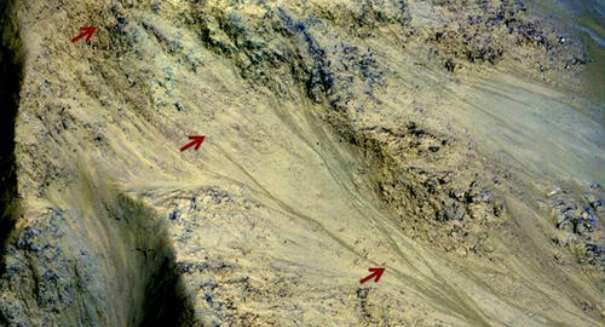
Mars might be more capable of supporting liquid water than previously though, but scientist say the strange dark markings may be remnants of a bygone era.
The Mars Reconnaissance Orbiter revealed seasonally changing marking on slopes that may be the result of salty water. The suspected water flows were first noticed two years ago on mid-latitude southern slopes. Given that they recede in winter and reappear in spring, scientists believe they may be evidence of freezing and thawing ice deposits beneath the planet’s surface.
“The equatorial surface region of Mars has been regarded as dry, free of liquid or frozen water, but we may need to rethink that,” said Alfred McEwen of the University of Arizona in Tucson, principal investigator for the Mars Reconnaissance Orbiter (MRO) High Resolution Imaging Science Experiment (HiRISE) camera.
Observation of recurring surface changes are but one example of the importance of monitoring Mars over an extended period of time, but they also reveal how much there is still to discover about Earth’s neighbor. The strange dark markings are typically no more than 16 feet wide, and the fact that deposits on both the north and south facing slopes respond to sun exposure indicate that it’s likely salty water. Five identified sites are in the system’s largest canyon network, the Valles Marineris
“The explanation that fits best is salty water is flowing down the slopes when the temperature rises,” McEwen said. “We still don’t have any definite identification of water at these sites, but there’s nothing that rules it out, either.”
As anyone who lives in a cold climate here on Earth can attest, salt is handy for maintaining liquidity at temperatures when fresh water would normally freeze. Salty water also has a slower evaporation rate, which allows it to flow farther.
Impacts with space debris have also lead to the observation of frozen water. Each year, Mars comes in contact with bits and pieces of asteroids and comets. When the particles hit the surface, they sometimes reveal previously hidden pools of ice.
“We’ve now seen icy craters down to 39 degrees north, more than halfway from the pole to the equator. They tell us that either the average climate over several thousand years is wetter than present or that water vapor in the current atmosphere is concentrated near the surface. Ice could have formed under wetter conditions, with remnants from that time persisting today, but slowly disappearing” said Colin Dundas of the U.S. Geological Survey.
Leave a Reply